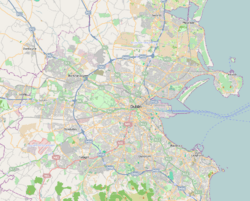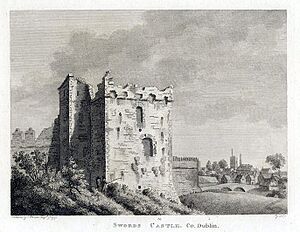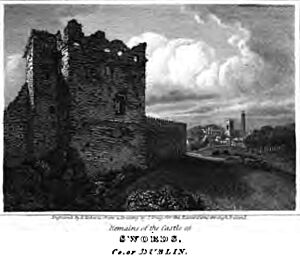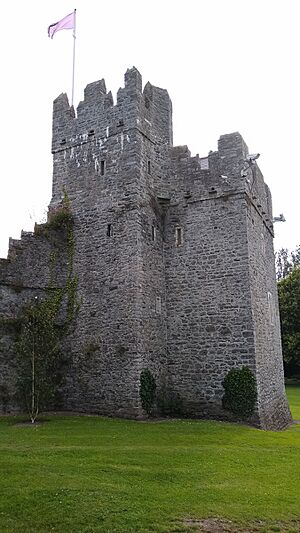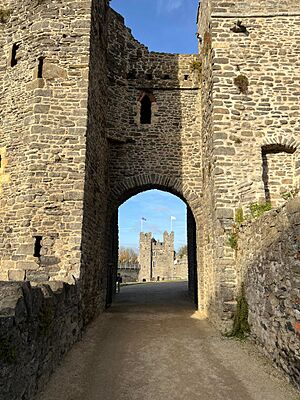Swords Castle facts for kids
Quick facts for kids Swords Castle |
|
|---|---|
| Caisleán Shoird | |
| Bridge Street, Swords, County Dublin | |
|
Clockwise, from top: Swords Castle wall with Constable’s Tower; The Chapel, Swords Castle; interior of the Constable's Tower; Swords Castle from Main Street, Swords
|
|
| Coordinates | 53°27′34″N 6°13′12″W / 53.459489°N 6.220015°W |
| Site information | |
| Owner | Fingal County Council |
| Open to the public |
Yes |
| Site history | |
| Built | Around 1200 AD |
| Built by | John Comyn (bishop) |
| In use | Still in use today |
| Designations | |
| Reference no. | 340 |
Swords Castle is an old castle in Swords, County Dublin, Ireland. It was built a long time ago, around the early 1200s, for the Archbishops of Dublin. The castle is located near the Ward River.
Over time, parts of the castle fell into disrepair, especially in the 1300s and 1400s. However, people still used it, at least partly, through the 1500s and 1600s. During the 1641 Rebellion, Irish Catholic families used the castle as a meeting place.
In the early 1900s, Swords Castle became a protected national monument. The Office of Public Works took care of it. Since the late 1900s and early 2000s, the castle has been slowly restored. Today, parts of it are open for tours. Fingal County Council now owns and protects this historic site.
Contents
About Swords Castle
What the Castle Looks Like
Swords Castle was built as a large home for the first Anglo-Norman Archbishop of Dublin, John Comyn. This happened around the year 1200 in Swords, just north of Dublin. The castle was not built to be a strong military fort. It is special because its outer wall is very long, about 305 meters. This wall is much bigger than most Irish castles.
The walls surround a large, five-sided area of almost 6,000 square meters (about 1.5 acres). There is a tower on the north side, which was probably where the castle's manager, called the Constable, lived. There is also a grand entrance gate on the south side. Inside the castle, there were rooms for the archbishop and for knights. There was also a big hall for feasts and gatherings. The guard might have lived in rooms near the gate. A priest's room was above the janitor's room. The chapel next to it, built in the late 1200s, was likely the archbishop's private prayer room. Other buildings, mentioned in old records from 1326, are now gone. This includes a large hall on the east side of the castle area.
Swords Castle History
Early Beginnings
A religious settlement, started by St. Columba (also known as Colmcille), existed in Swords from the 500s. In the 1600s, the Archbishop of Dublin took control of this area. In 1181, John Comyn became the archbishop. He likely chose Swords as his main home because the land there was very rich. Records show he had a large estate in Swords by 1192. At that time, he was allowed to hold a yearly fair there. This fair lasted a week, starting on St. Columba's feast day (June 9). Most people agree that the castle was built around 1200 as the archbishop's main residence. The archbishop had his own manager, called a seneschal, at Swords. A church court was also held there. In 1216, the Swords estate was given to Henry de Loundres, the second English Archbishop. In 1220, a man named William Galrote was the chief constable of the castle.
Abandonment and Decline
The castle was used by different Archbishops of Dublin for about 100 years. Then, Archbishop Alexander de Bicknor built a new palace in Tallaght in 1324. It seems Swords Castle was left empty around this time. We know this because in 1326, de Bicknor was accused of mismanaging money. The king took control of his profits, and an investigation happened. This investigation described Swords Castle in detail. It showed that the castle was in bad shape.
Swords Castle was probably abandoned because of damage from the Bruce campaign in Ireland in 1317. This war caused a lot of destruction from Dundalk down to Dublin. Even though there is no direct proof that Bruce's army attacked Swords Castle, it was not strong enough to defend itself. The archbishop likely moved to Tallaght for safety.
Later Use and Restoration
It is not clear if all the castle buildings were ever fully repaired. However, the stepped walls suggest that someone lived there during the 1400s. It seems the castle was given to archbishops who had retired. But there are no records showing they actually lived there. Instead, it seems that at least part of the castle was used by a constable (a castle manager) during the 1300s, 1400s, and early 1500s. As late as 1547, Thomas Fitzsimons of Swords was appointed constable. Later, the Barnewall family also had a role in managing and renting the castle. But by 1583, when some Dutch Protestants briefly lived there, it was called "the quite spoiled old castle." The ruler, Sir Henry Sydney, had some parts repaired for the Dutch weavers. He hoped they would teach the local people how to be industrious.
During the 1641 Rebellion, Anglo-Irish Catholic families from The Pale met at the castle. On December 9 of that year, they gathered with weapons to join the rebellion. But Sir Charles Coote attacked them. He chased them out of the castle and killed 200 of them. Some burials found during recent digs at the castle might be from this event.
Not much is known about the castle after this. But an old map from 1837 shows that the castle grounds, called the Bawn, had become a garden. After the Church of Ireland was no longer the official church in 1870, the castle was sold to the Cobbe family. They rented it to a local shopkeeper named Robert Savage. Savage turned the castle grounds into an orchard and sold the fruit in his shop.
In the 1930s, the Office of Public Works took over the care of the site. In 1985, Dublin County Council (which later became Fingal County Council) bought the castle. Their goal was to restore it. The Parks Department of Fingal County Council studied the area. In 1995, a plan was agreed to restore the castle step by step over a long time. In 1996, work started on restoring the Constable's Tower, and it was finished in 1998. The rest of the castle is still being restored. When it is fully done, Swords Castle is planned to be a major tourist spot. The newly fixed castle was used to film the TV series The Tudors in spring 2010. In 2019, the chapel started hosting weddings. Swords Castle and its courtyard are open to visitors from Tuesday to Sunday.
See also
 In Spanish: Castillo de Swords para niños
In Spanish: Castillo de Swords para niños






